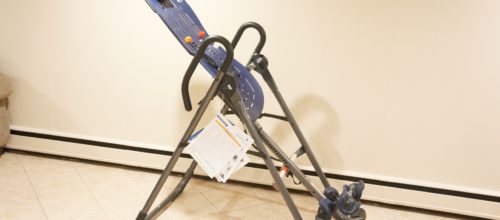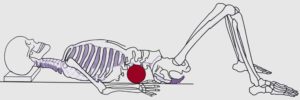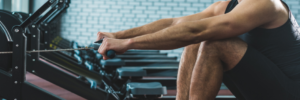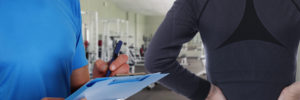
Can an Inversion Table Help Provide Low Back Pain Relief?
Once in a while, I’ll get a question from someone asking me what my thoughts are on using an inversion table for low back pain relief.
My response tends to be:
“I credit the inversion table as the best accessory tool to helping in my recovery from an L5-S1 disc herniation causing sciatica; however, it’s not for everyone. Some people may get worse using an inversion table, and there were a few instances towards the end of my recovery were using an inversion table triggered a pain response. The one thing you need to consider when using an inversion table is that it creates a traction force on the spine. Traction creates destabilization. If someone has instability in their low back due to degenerative changes (e.g., facet joint osteoarthrosis) — using an inversion table is perhaps not the best idea since it creates further instability. That’s where people need to be careful when it comes to using an inversion table. But where people do get relief — it tends to be from reducing the size of a disc bulge, which could take pressure off a pinched nerve.”
From the above response — I’m a believer that the inversion table can help people, but only in the proper context. People that respond well to traction are going to get relief, but people that have instability in their lumbar spine may respond with pain from traction. Often people won’t know if an inversion table is right for them until they try a form of lumbar traction (e.g., pushing up on a bench, hanging from a pull-up bar, inversion table, manual traction).
People Need to be Careful with Creating High Traction Forces (Hanging Upside Down) on a Facet Joint with Degenerative Changes (Video Above).
Also, a separate issue I see is that people believe the inversion table is the device that will cure their low back pain. But the inversion table is an accessory tool — not the “single” solution to their low back pain.
For the inversion table (inversion therapy) to provide results — it needs to be combined with a global program (e.g., exercise, spine education) that addresses the person’s low back pain and goals. Prasad et al., (2012) found that the use of an inversion table combined with physical therapy is more effective than physical therapy alone in reducing the need for herniated disc surgery. Prasad et al., (2012) research is a good example showing the effectiveness of an inversion table when combined with a good recovery program.
Breakdown of the research:
Participants with an L4-L5 or L5-S1 disc protrusion causing nerve pain aged 18-45 years old were recruited. The participants first and best treatment option recommended by a neurosurgeon was surgery (microdiscectomy).
Participants were randomly assigned into 1 of 2 groups:
- Physical therapy alone (11 participants) for four weeks
- Inversion therapy combined with physical therapy (13 participants) for four weeks (inversion therapy consisted of using an inversion table 3x per week for a total of 6 sets (2 minutes per set) per session.
The researches found that 10 out of 13 participants in the inversion therapy + physical therapy group were able to avoid surgery, and only 2 out of 11 participants in the physical therapy only group were able to avoid surgery. The researchers concluded that inversion therapy combined with physical therapy might be an effective option in reducing the need for surgery in people with lumbar herniated discs causing nerve pain.
The research study provides a good example of the positive effect (reducing the need for surgery) that an inversion table can provide. But people need to think of an inversion device as a ‘good’ complimentary tool to an already good recovery program. People tend to think of an inversion device as a magic bullet, but it’s not, and marketers are to blame for these mindsets that people have.
How Long Should You Invert For?
I think everyone will be different in how long they need to invert. But I found 2-3 minutes per session to be sufficient in providing relief. I think anything longer may be a bit overboard and could perhaps start to cause headaches and dizziness. It’s perhaps best to start with a short interval and as you get comfortable hanging upside down — you can increase your duration.
A Few Other Considerations:
Outside of the of the instability effect were traction can trigger a pain response – there are a few other considerations to think about before using this device. Hanging upside down increases systolic blood pressure, diastolic blood pressure, and intraocular pressure (Klatz, Goldman, Tarr, & Pinchuk, 1983). People with hypertension, cataract surgery, retinal degeneration, or other previous head/chest problems need to be careful with using an inversion table and should consult with their primary physician before using the device.
Final Thoughts
For people with low back pain — the inversion table works, but only in the proper context. People with instability issues in their low back or previous head/chest problems should consult with their primary physician before using the device. Also, remember that an inversion table is an accessory tool that works best alongside a good recovery program.
References
Klatz, R. M., Goldman, R. M., Tarr, R. S., & Pinchuk, B. G. (1983). Gravity inversion therapy. The Western journal of medicine, 139(4), 538-40.
Prasad, K. S. M., Gregson, B. A., Hargreaves, G., Byrnes, T., Winburn, P., & Mendelow, A. D. (2012). Inversion therapy in patients with pure single level lumbar discogenic disease: A pilot randomized trial. Disability and Rehabilitation, 34(17), 1473-1480.











